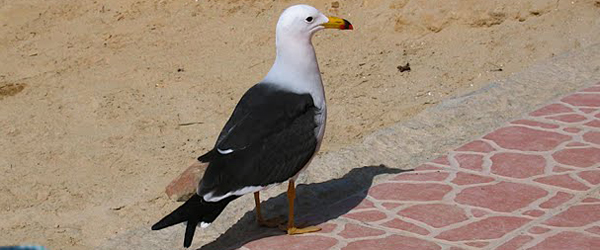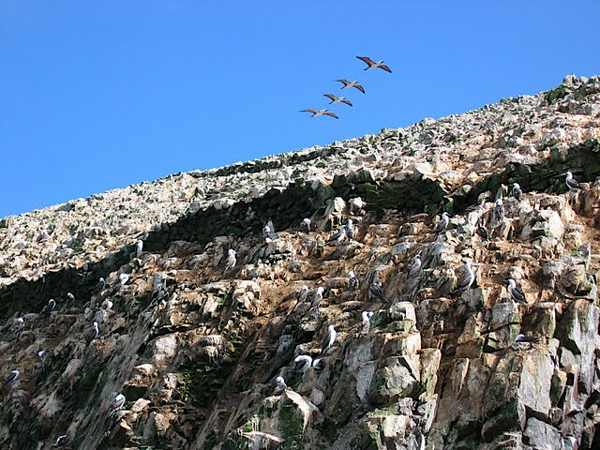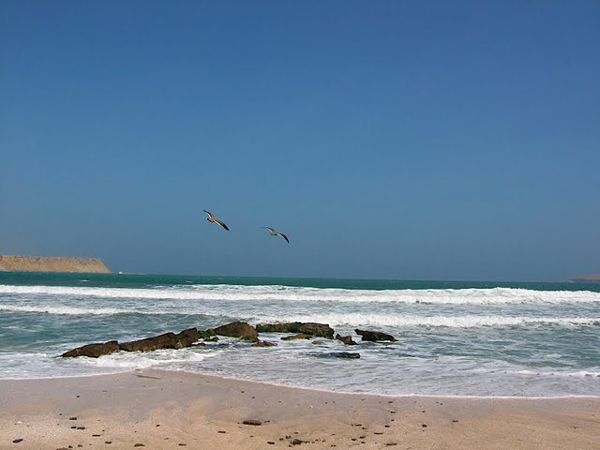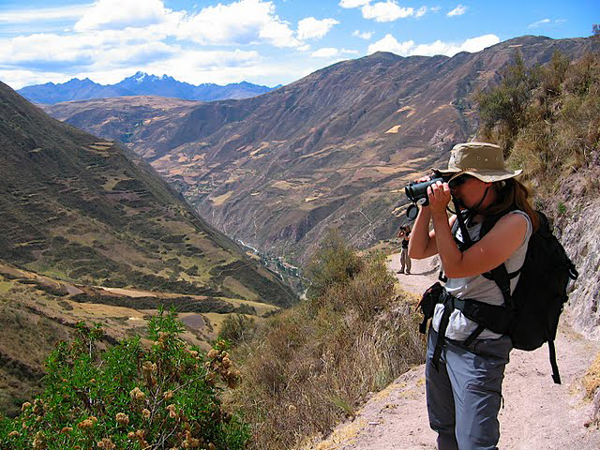Chrissy Guarino is our most prolific guest blogger, having shared one story after another with the readership of 10,000 Birds. In this post she shares her experiences trying to identify birds off the coast of Peru and while hiking to Machu Picchu (without an expert bird guide) from the 14th to the 24th of July. Despite not being able to identify most of the passerines she spotted she still managed to see some great birds (and get some good pictures). Many thanks to Chrissy for agreeing to share this tale on 10,000 Birds!
First of all, let me say that my trip to Peru was not specifically a birding trip (gasp!), I did not hire a guide and I did not have much time to study my field guide before I left (gasp!). The primary goal of the trip was to hike with a friend in the Andes on a guided trek that did NOT follow what is traditionally called the Inca Trail. That trail was too crowded – we wanted a challenging hike that would give us the opportunity to see some Inca sites but would also give us a taste of the Andes, and we certainly got that. But, this is a birding blog, so I will try to keep the focus to the birds. If you would like information on the hike we did and the tour company we used, feel free to contact me through Corey and I’d be happy to make recommendations.
We arrived in Lima a few days before we needed to meet up with our hiking group so we set off three hours to the south to visit a sleepy little beach town called Paracas, which I had scoped out in the book as a great way to combine a trip to the beach with an opportunity to see birds. A group of islands, referred to by some as the Poor Man’s Galapagos but officially named Islas Ballestas, is just a short boat ride from Paracas. A very inexpensive fee (about 10 USD) will get you a guided two-hour boat ride and it is well worth it.
Before embarking on the boat we were treated to incredibly beautiful Inca Terns, Band-tailed Gulls, Grey-headed Gulls, Peruvian Pelicans and Peruvian Boobies hanging around the marina area. I was excited to make our way to the tiny islands where these and other species breed and where guano is still harvested every 5-8 years. I was anticipating seeing the namesake of this fine fertilizer, the Guanay Cormorant among other guano-producing species.
During the ride out to the islands we paused to observe the Candelabra, a mysterious hillside drawing resembling the more well-known Nazca lines which are found about three hours from Paracas. No one really knows who is responsible for the Candelabra, but I was happy to have the boat stop for a bit so I could observe some Guanay Cormorants, Neotropic Cormorants and Inca Terns. There was also a basking sea lion hanging out on the beach and I managed to catch a Blackish Oystercatcher in a photo of Inca Terns and cormorants.
As we approached the islands we were treated to an incredible show of Peruvian Boobies diving like torpedoes into the Pacific – my traveling buddy was quite impressed with this behavior. Arriving at one of the islands I was the first person to shout that I could see some Humboldt Penguins (I was the only one with binoculars, if you can believe it)! There were two of the cutest Humboldt Penguins hopping around on the island among the ubiquitous Peruvian Boobies.
We also saw a few Red-legged Cormorants, which are quite beautiful indeed. Our two-hour boat ride was packed with awesome birds, sea lions and other marine life. The rest of our day was to be spent on land touring the Reserva Nacional de Paracas – a stretch of some of the driest land on planet Earth, second only to the Sahara. Here we were treated to spectacular ocean views and Grey Gulls soaring eye-level over the cliffside beaches. We also had a Band-tailed Gull offer to help us finish our delicious fresh seafood lunches. After the beach, we were off to the Andes Mountains and Machu Picchu!
We arrived in Cusco and enjoyed this small mountain city, which is built over the former capital of the Inca Empire. There are beautiful Inca walls in the old part of the city mixed with Spanish colonial cathedrals, just as Francisco Pisarro envisioned it, I suppose. As we wandered around the city I often encountered mixed flocks of tiny unidentifiable passerines. My field guide was too heavy to cart around everywhere so I decided I’d limit myself to raptors and hummingbirds for the rest of the trip. This was a good decision because everything else for the most part was too hard to identify!
We started our hike after a few days in Cusco to acclimate to the 10,000 foot plus elevation. On the first day I saw multiple Variable Hawks and the most incredible Giant Hummingbird. This hummingbird was so strange! It looked like a moth at a porch light barely managing to hover at flowers for too long. It would often perch to take a breather. Very cool! There were also many Mountain Caracaras seen throughout the day, giving great looks as the hovered at eye level.
During the four days of hiking, these were the birds I saw the most. In one location, Chillipahua, I also found some awesome Andean Lapwings. They were easy enough to identify as well as a few new hummingbirds: Great Sapphirewing and White-tufted Sunbeam. There were numerous maddening LBJs and LYJs (little yellow jobs) that I didn’t have a prayer of identifying. Near the end of the second day we came across two pairs of the strangest geese I’ve ever seen: Andean Geese. Our guides called them by their Quechua name, Huallata. They are huge white and black geese that hang out at high elevations in the Andes. I thought at first that maybe they were domestic geese but my guides said they are wild Huallata. Very cool!
I’ve rambled on for quite some time and now it is time to drop the bird of the trip’s identity (though I’m sure you probably know what’s coming). On the third day of hiking, one of the guys in our group, Matt McCulley from Boston who must have 20-10 vision said, “I see a huge bird flying across the glacier,” which could of course mean only one thing. I managed to get my bins on this bird (which was really far away) and soon was able to see the long dark wings with white secondaries above. An Andean Condor! At this point I tried to describe its location above the Urubamba River valley near Ollantaytambo but no one was able to pick up the distant-and-getting-more-distant-every-second condor. I don’t know how Matt saw the bird but I am so glad that he did! It was spectacular!
We later took the train from Ollantaytambo to Aguas Calientes and I glimpsed a few Torrent Ducks on rocks in the Urubamba River and from a restaurant was able to watch a cute White-capped Dipper doing his thing in the river below. On our last day of the trip at Machu Picchu I was treated to an excellent photo opportunity when a Mountain Caracara landed twenty yards away and allowed my to approach with my little point-and-shoot camera to about ten yards. Machu Picchu was full of Blue-and-white Swallows and Rufous-collared Sparrows, which are possibly the most common bird in all of Peru and likely South America.
Peru is really a cool place to visit but if you don’t have much experience with tropical birding, definitely go with someone who does. I plan to return after doing some more homework and definitely will hire a guide while I’m down there because I can’t even imagine how many awesome birds I missed. I am very satisfied with the birds I did see and identify. They were spectacular and my trip was incredible! Thanks to 10,000 Birds for letting me share my trip with you!















Thanks Chrissy for this tale. It is always a treat to see a post about birding Peru even when not birding Peru. For anyone else that wants to do the same, bird on a non-birding trip to Peru, there are two field guides that I recommned that could have helped. Birds of Chile by Alavaro Jaramillo a thin, but excellent book for the coast west slope of Peru and Birds of Machu Picchu by Barry Walker and illustrated by Jon Fjeldså. The latter covers practically all the birds that you will see in Cusco above 2000 meters and is the perfect companion for a hiking trip.
Chrissy: Nice post!
Gunnar: thanks for the info – useful to know
Thanks Gunnar and Charlie! I forgot to mention the colony of Chilean Flamingoes at the Reserva Nacional de Paracas….oops!!
Wow! I am impressed! You saw enough “lifers” to justify the trip even though you missed some. Seems like an incredable adventure.
Great recap Chrissy. Congrats on all the wonderful birds! Glad you got to see the Condor. I was lucky to see one at close range on my trip to Ecuador several years ago.
Hey Chrissy, congrats on a great trip! Reading your list of birds makes me jealous, especially when I think about if that is a partial list of just the birds, what about all the additional plants and wildlife?? I like how you are already planning the next trip!